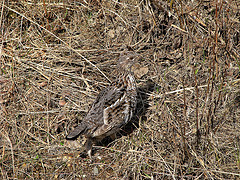Adaptations
The toes of the ruffed grouse gain little projection-like extensions on their toes in the winter, and researchers believe that this helps them walk in the snow, like snowshoes. They also have feather-covered legs, unlike most birds, to protect them from harsh winters.
Another adaptation of the ruffed grouse is seen in the food it eats. In the summer the bird feeds on berries, fruits, and seeds. In the winter it feeds on the catkins and buds of deciduous trees. This adaptation allows the bird to overcome feeding challenges faced by being a permanent resident of an area with extreme climate changes season to season.
Furthermore, the coloring of the grey morph ruffed grouse blends in extremely well with its habitat, especially in the winter when their surroundings are covered in snow. The coloring of the red morph also tends to blend in to its surroundings well, as it tends to reside in hardwood forests which tend to have a variety of red leaves. This adaptation is useful for protection from predators. According to grouse hunters, this particular bird, regardless of the morph, is incredibly difficult to spot when walking through the woods.


